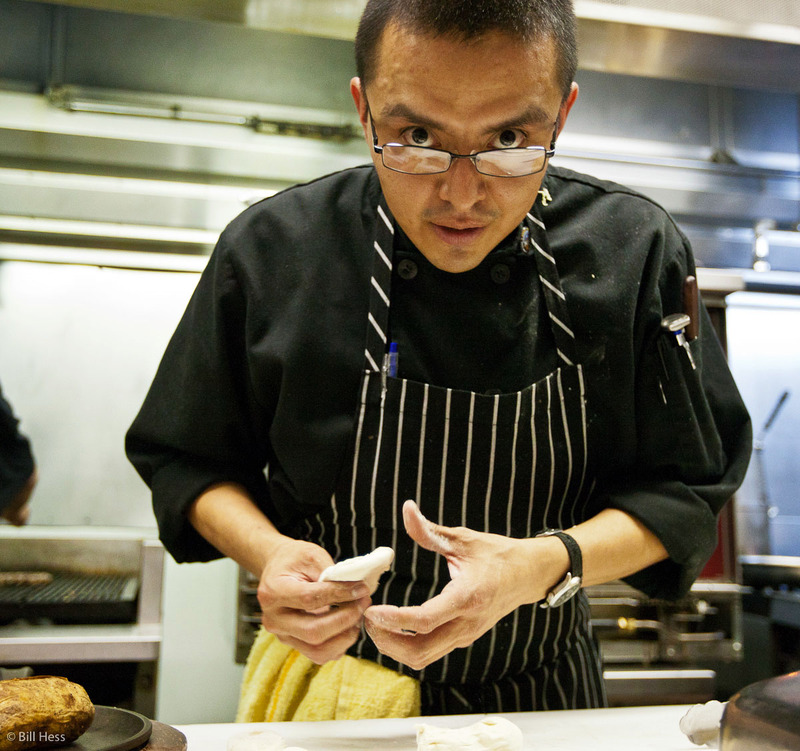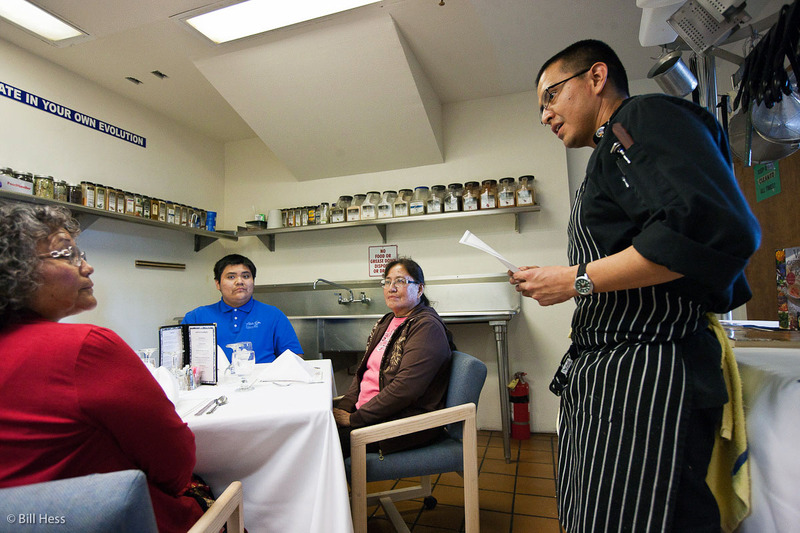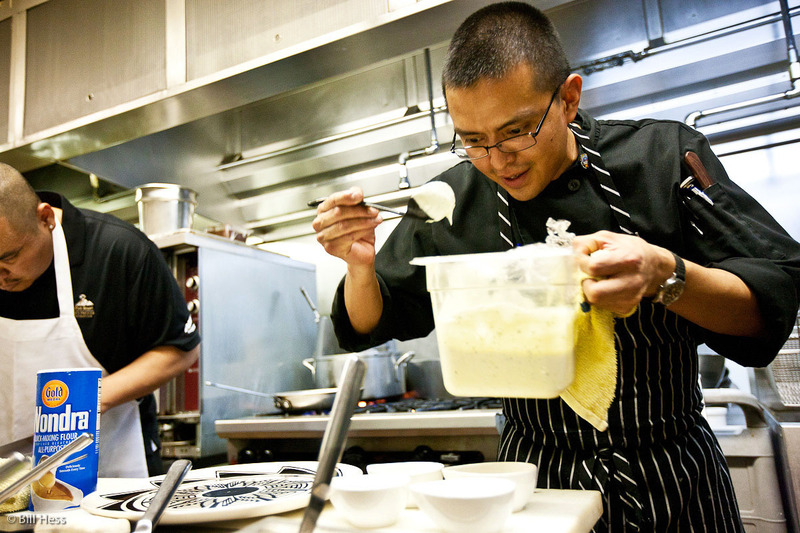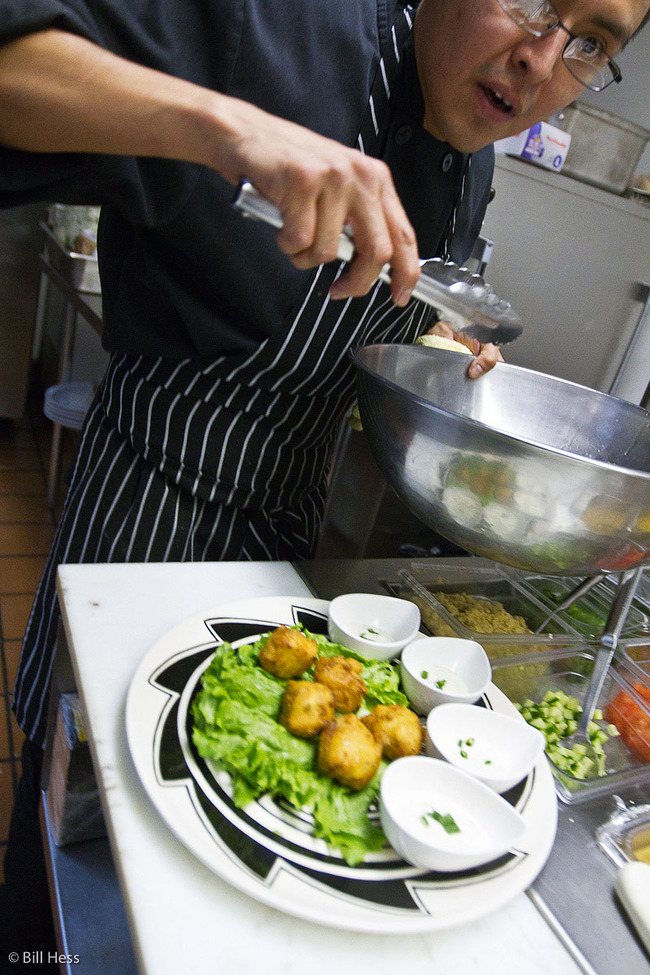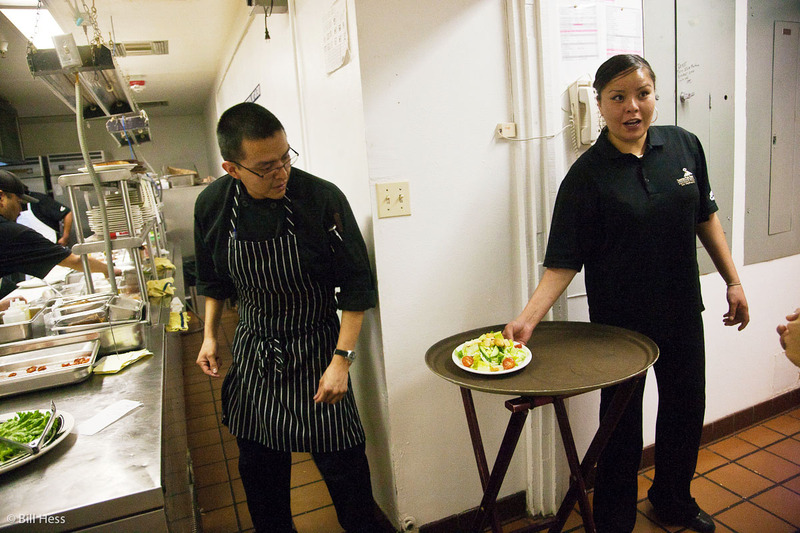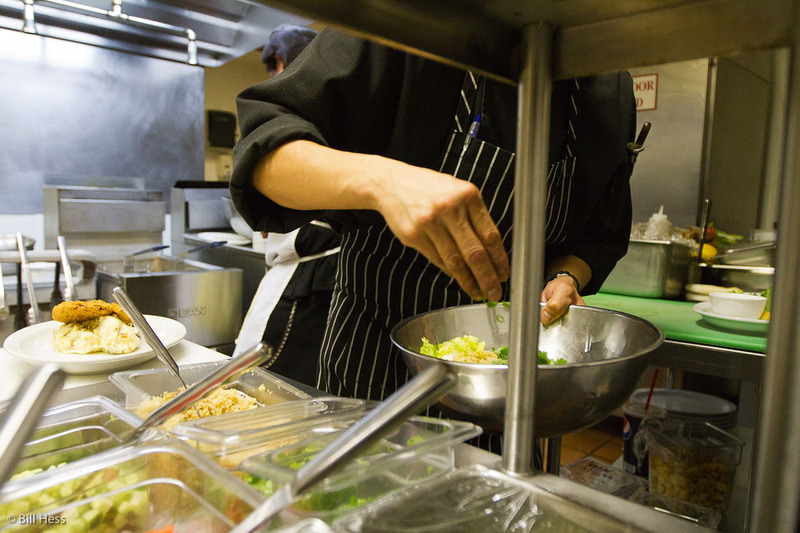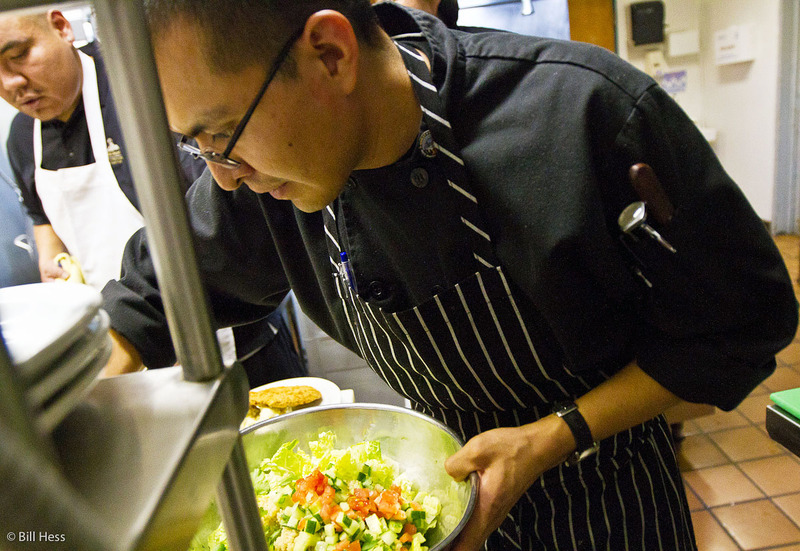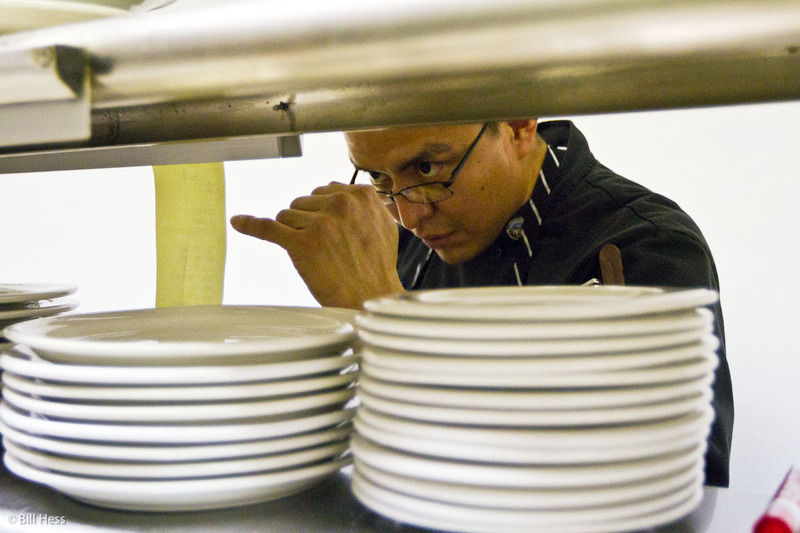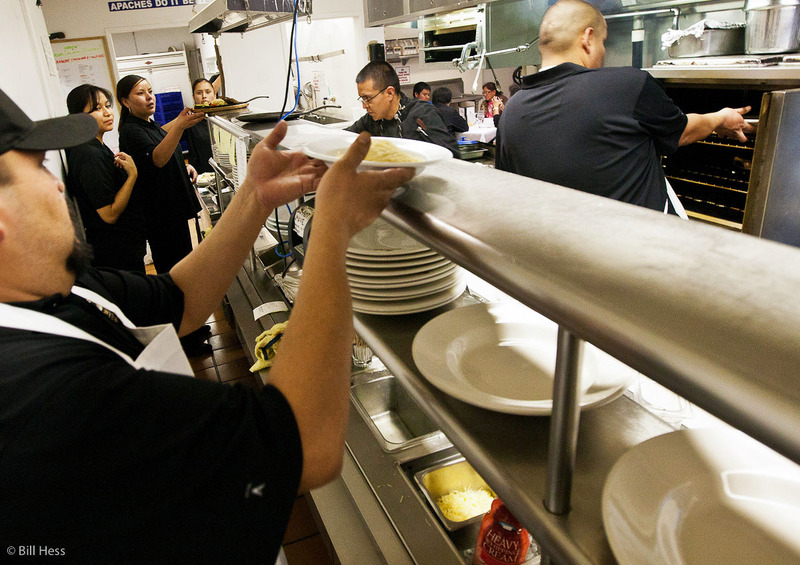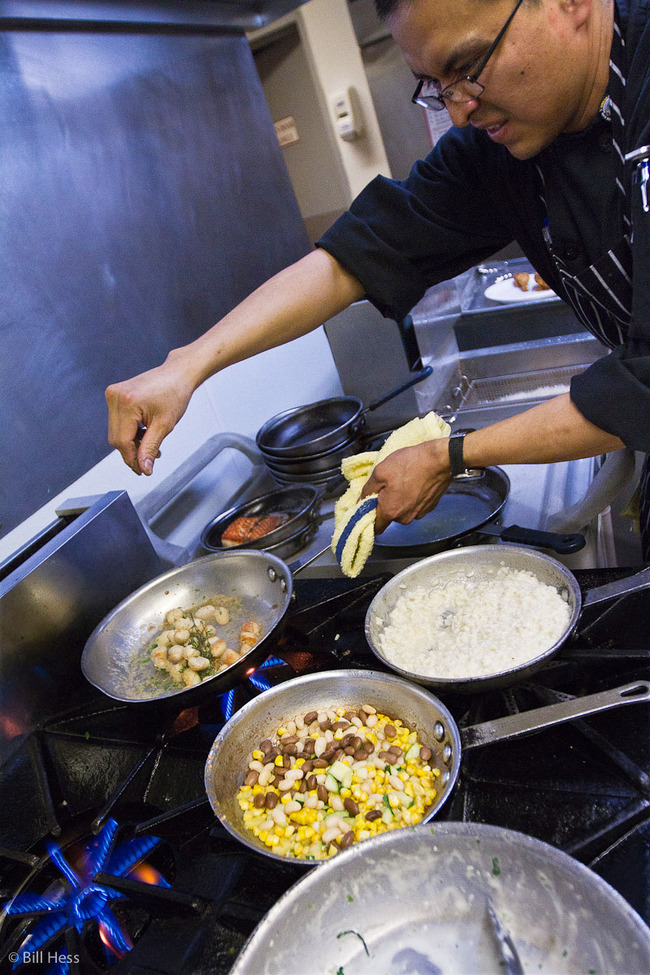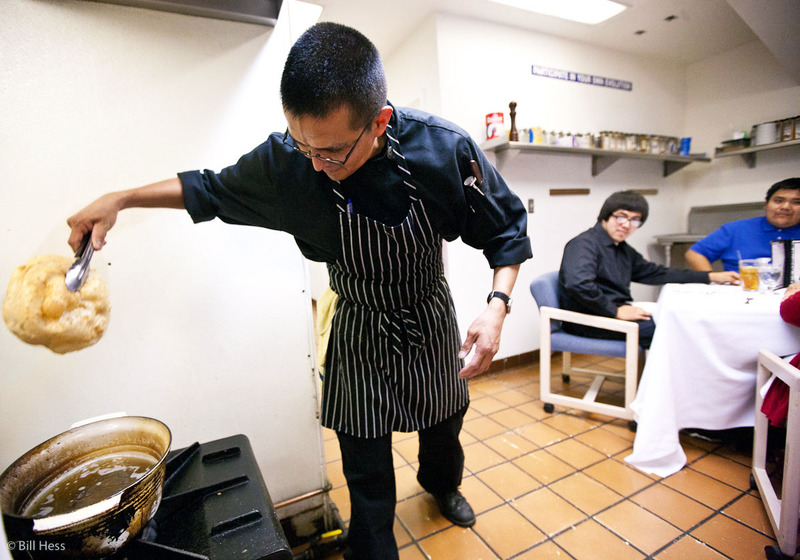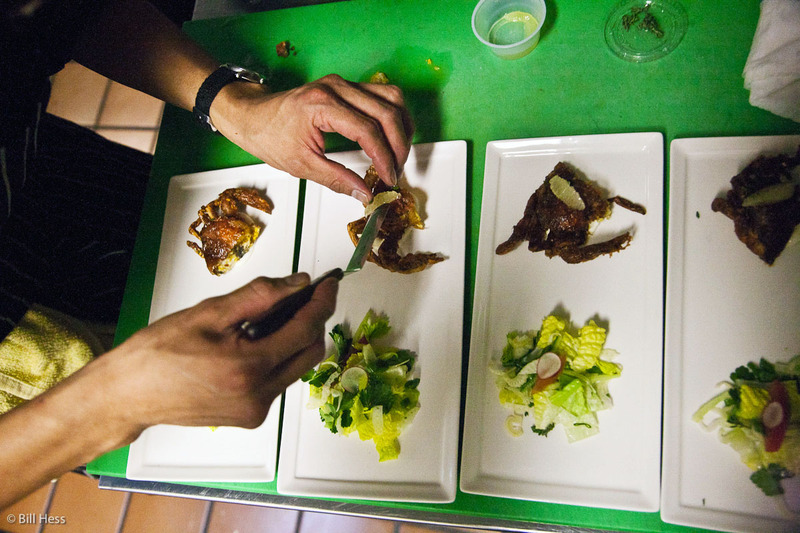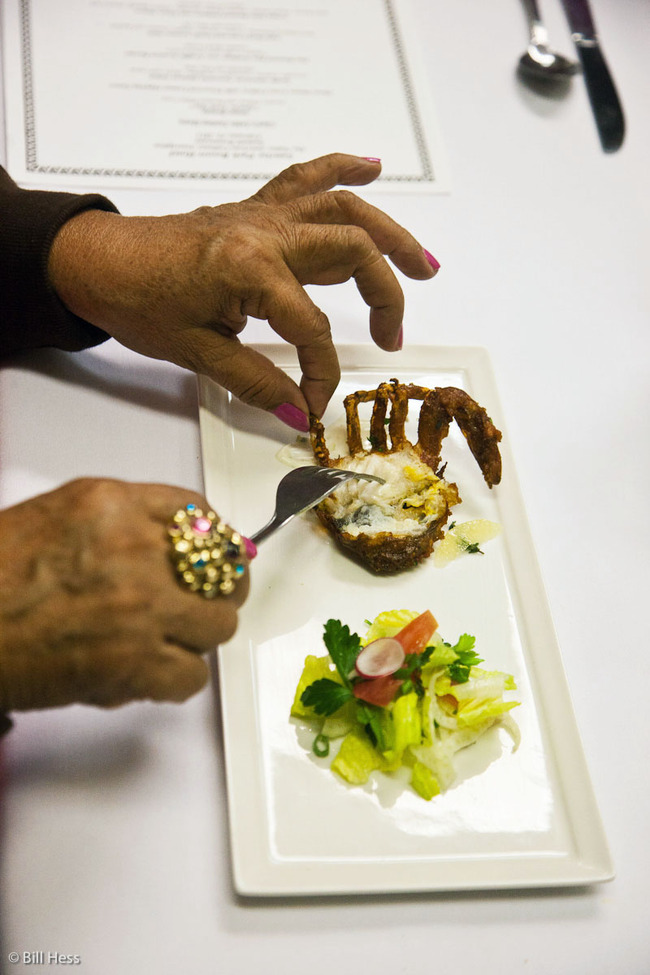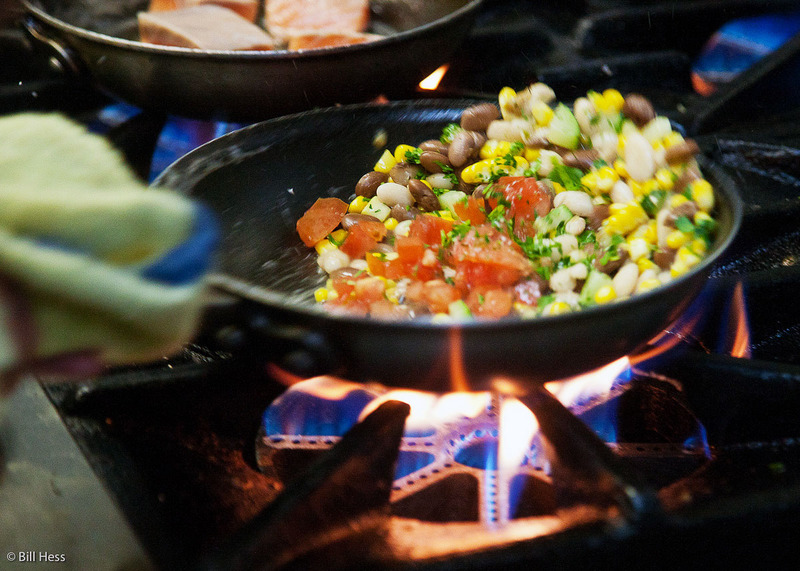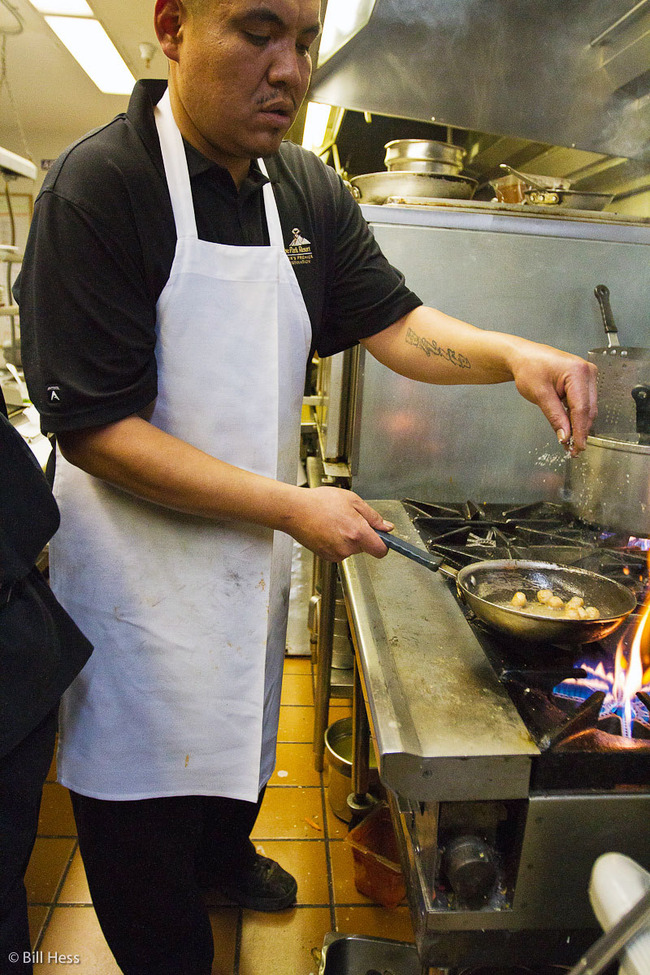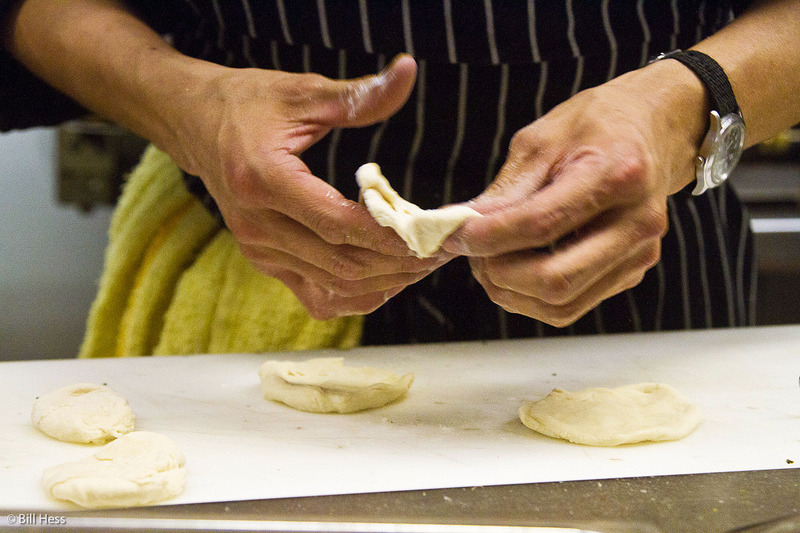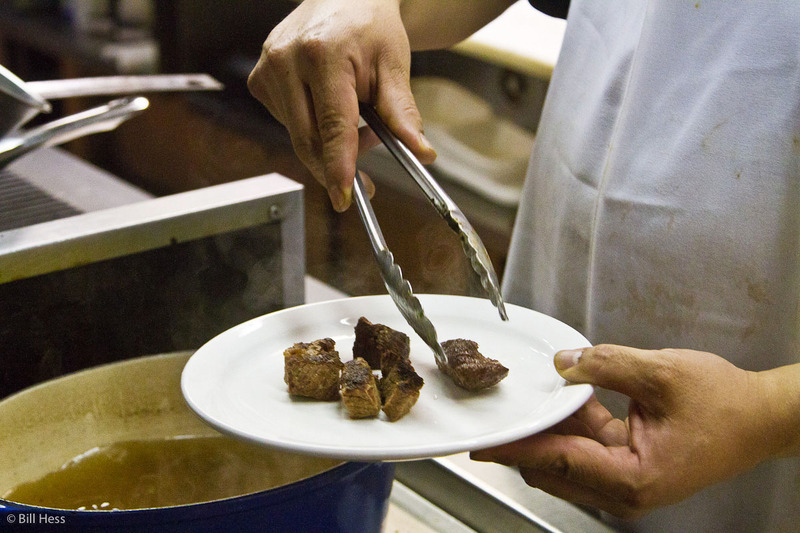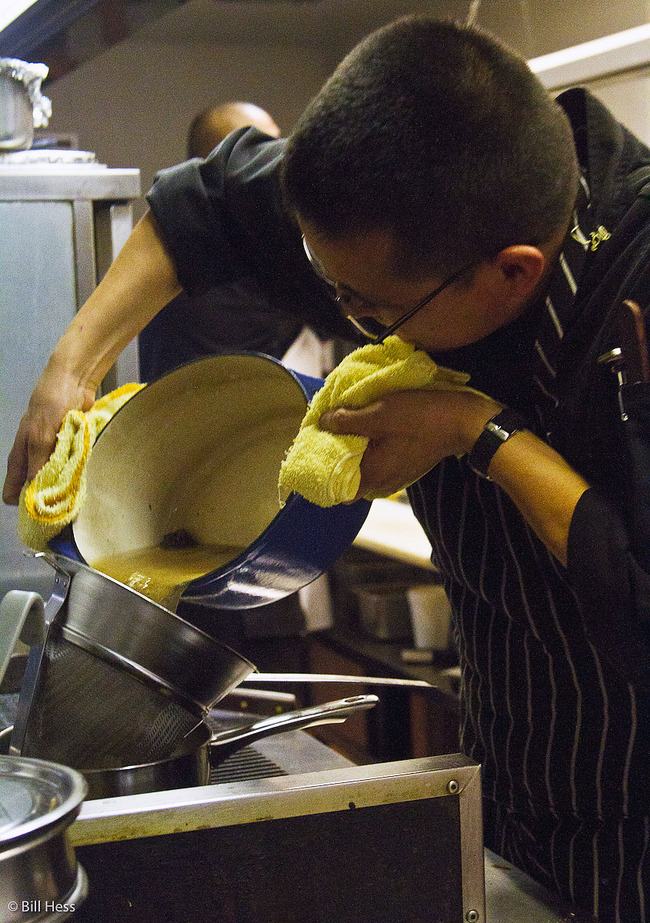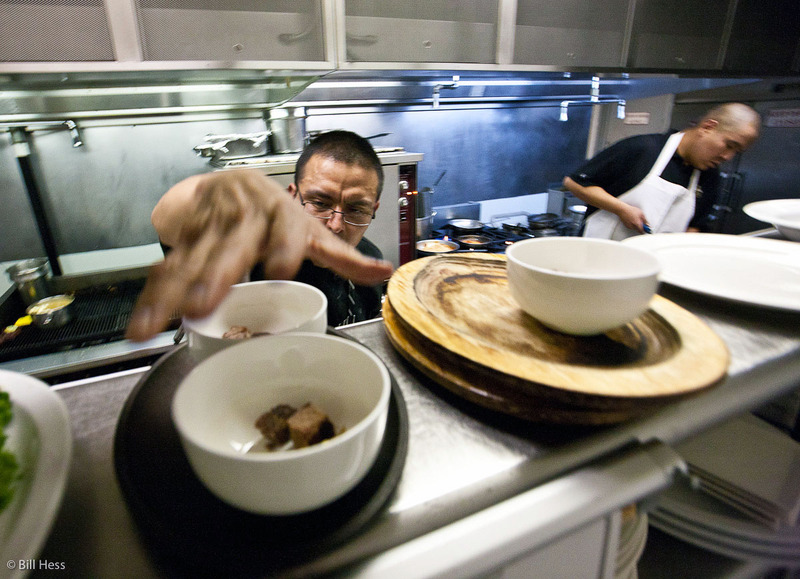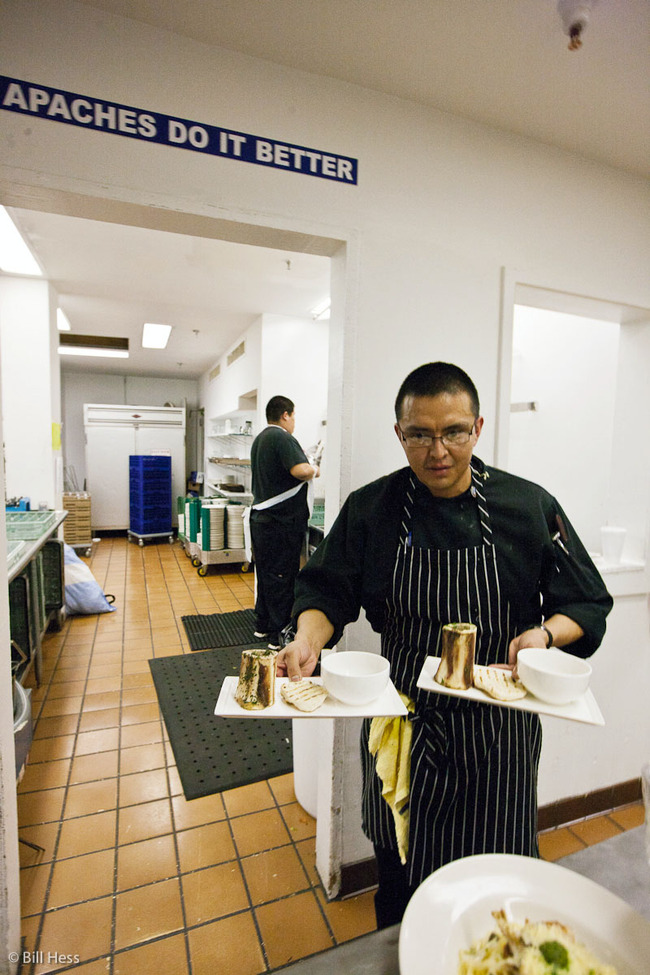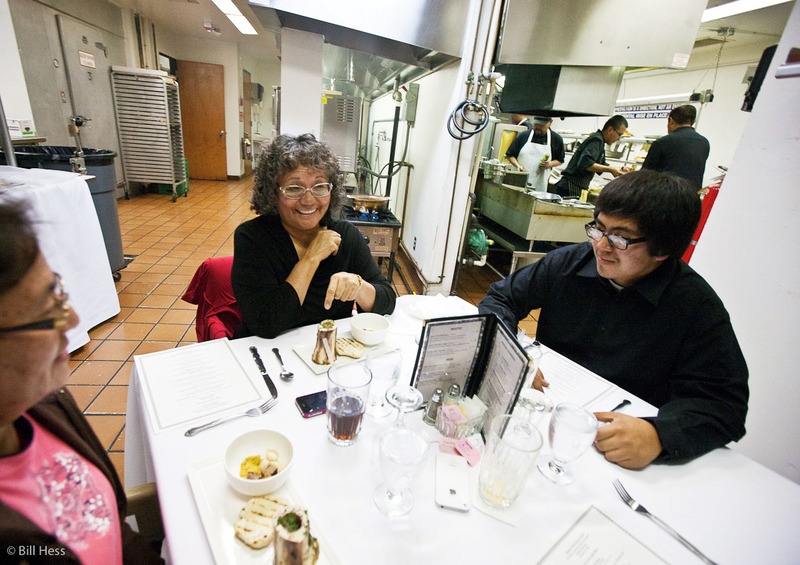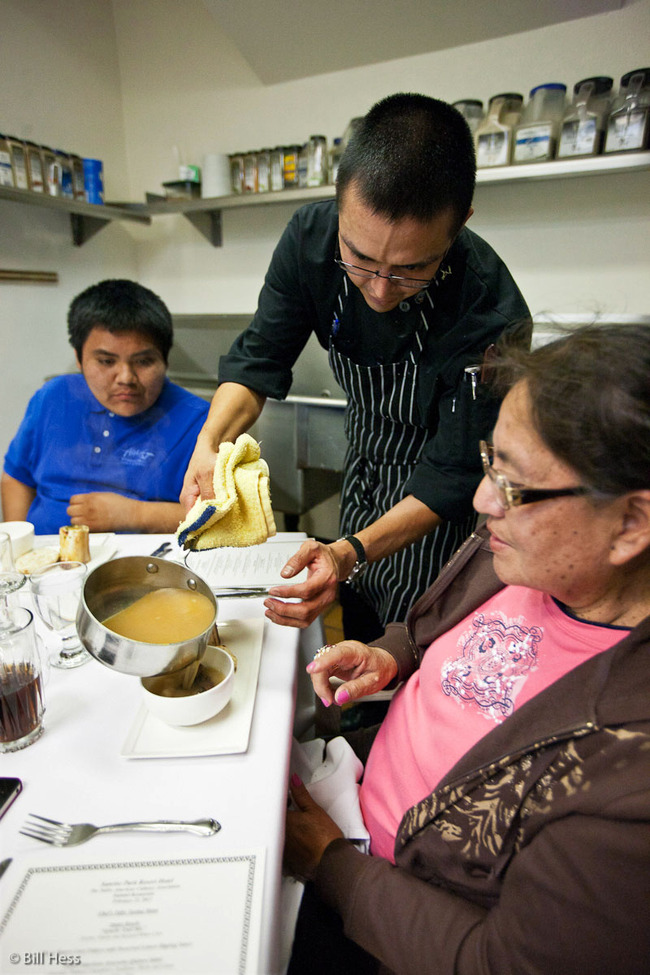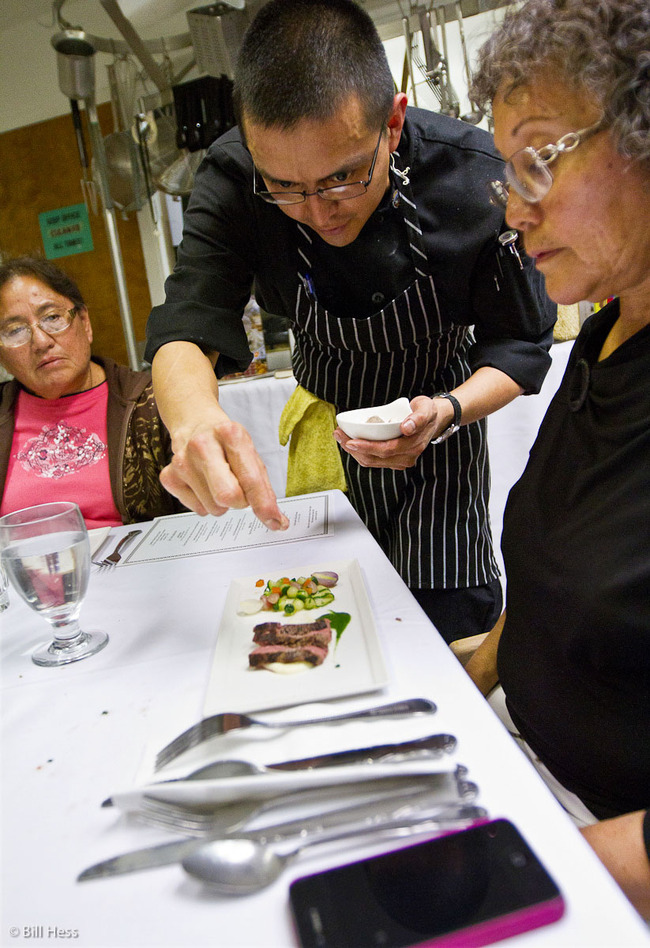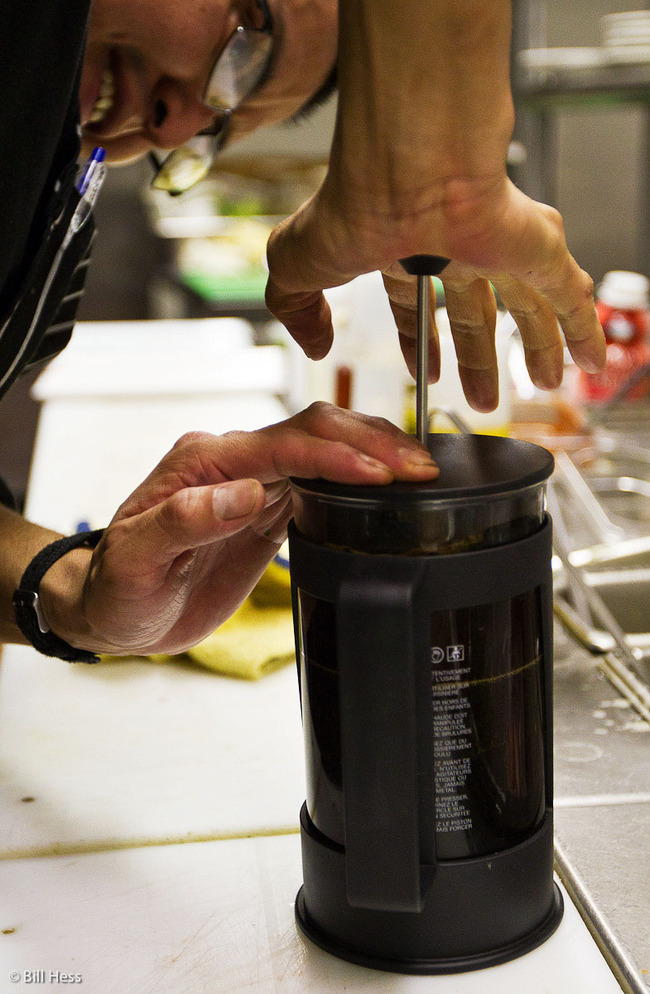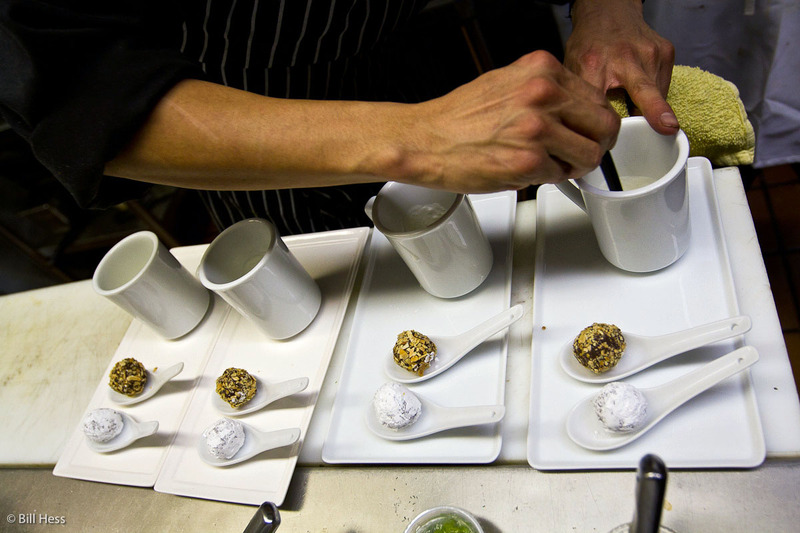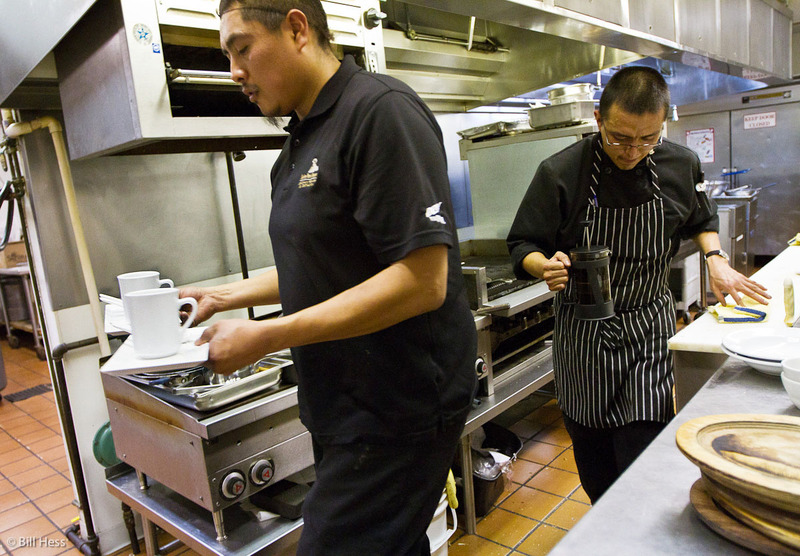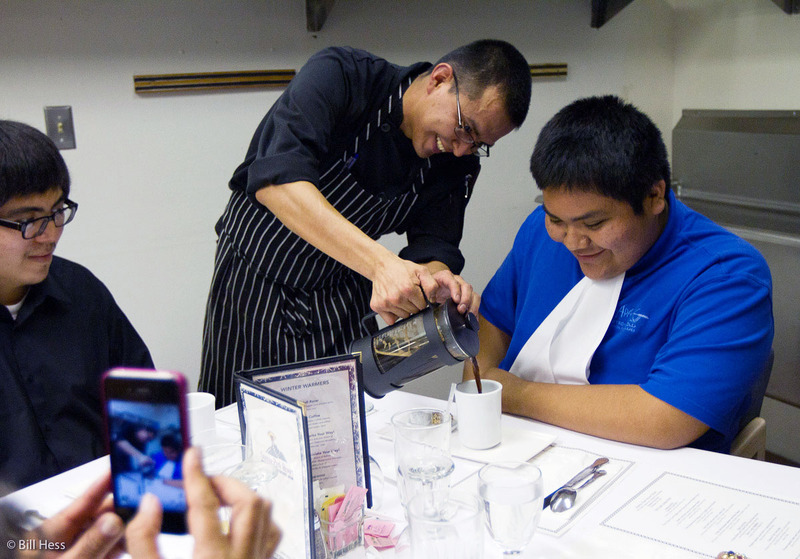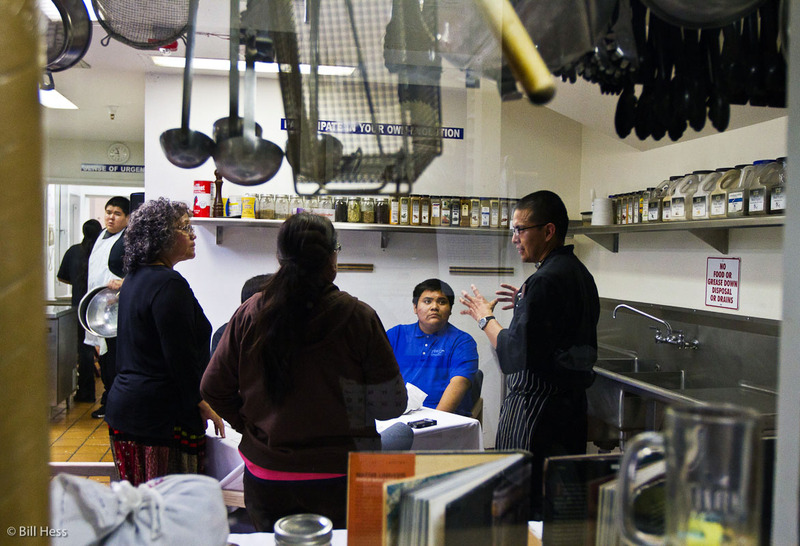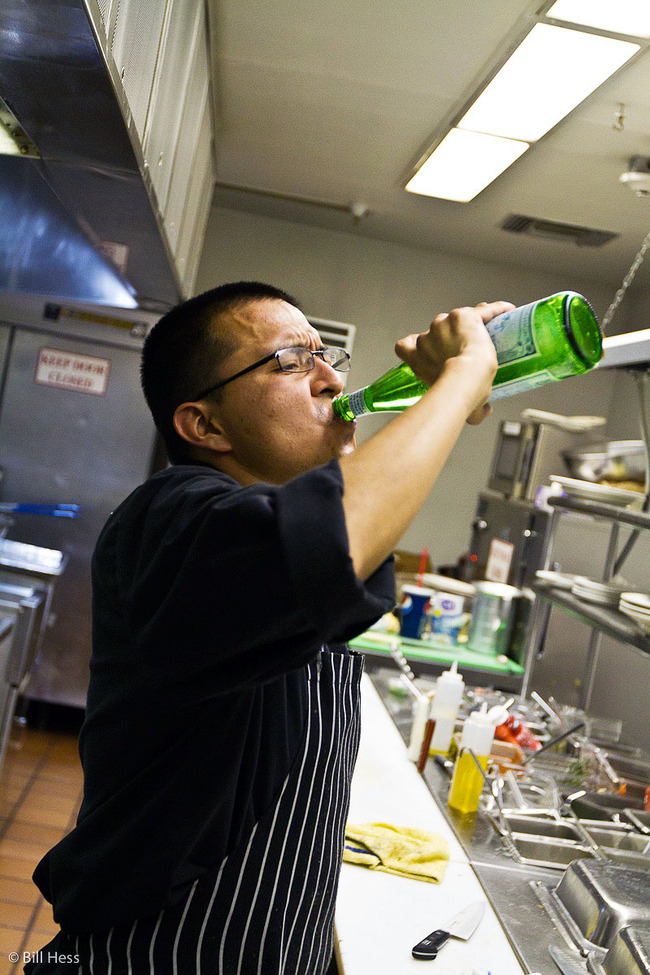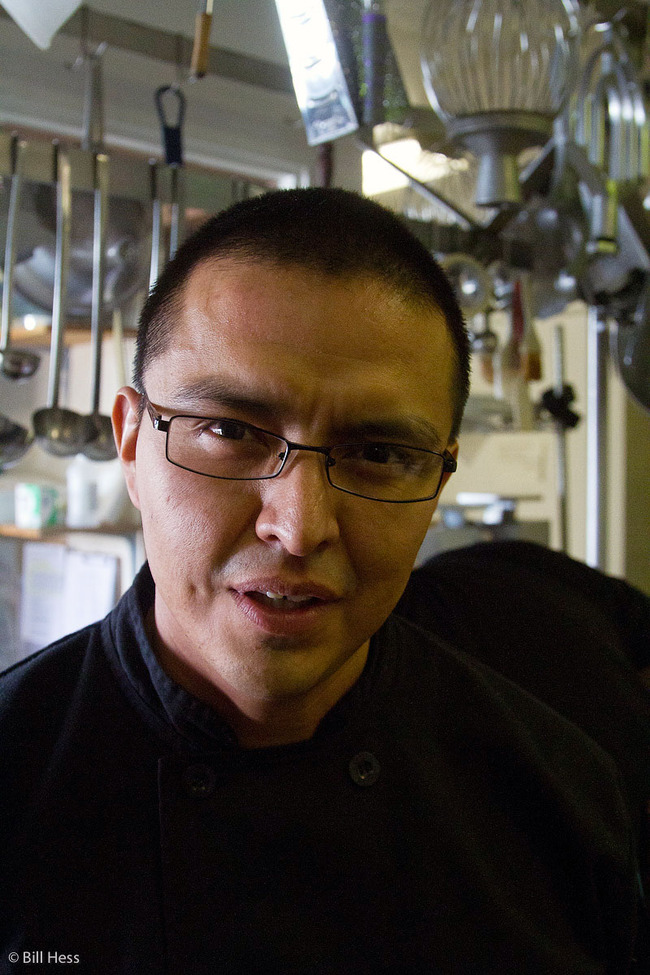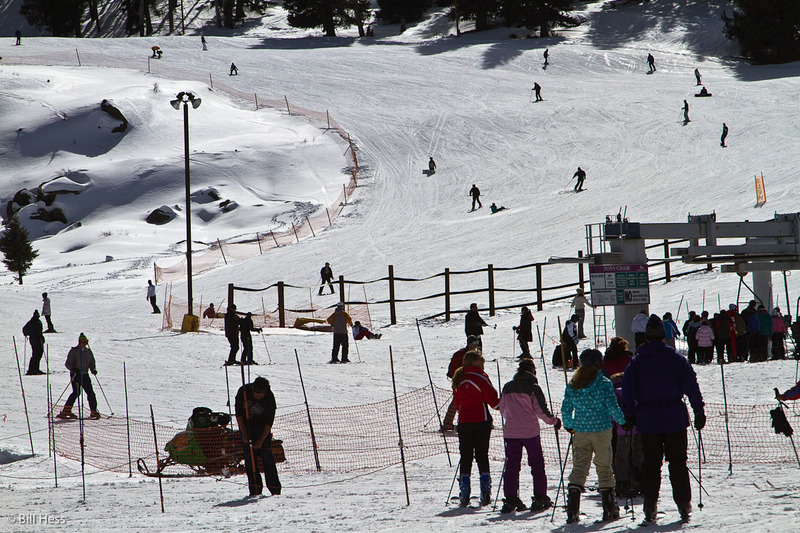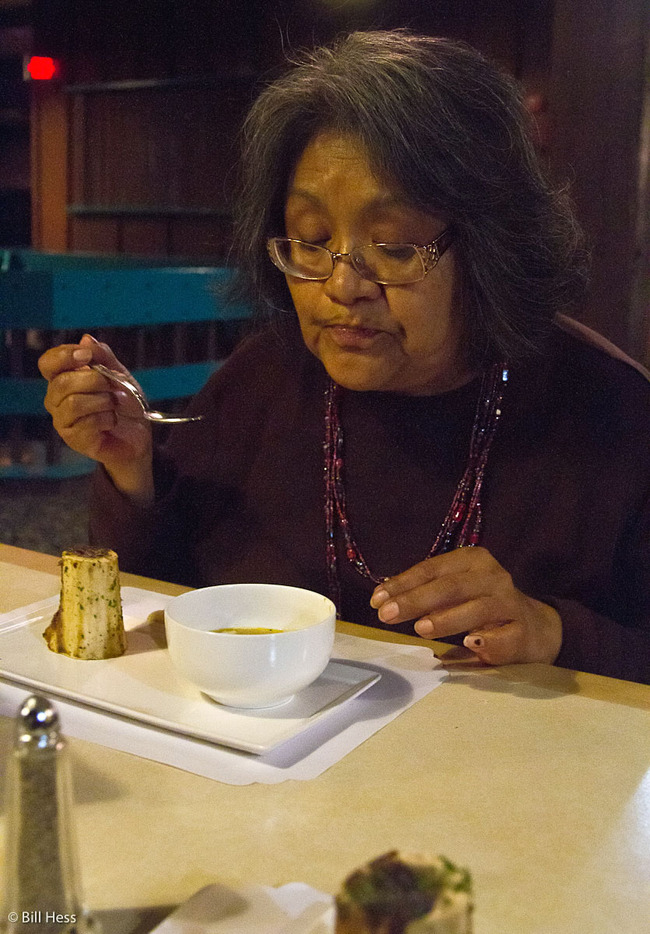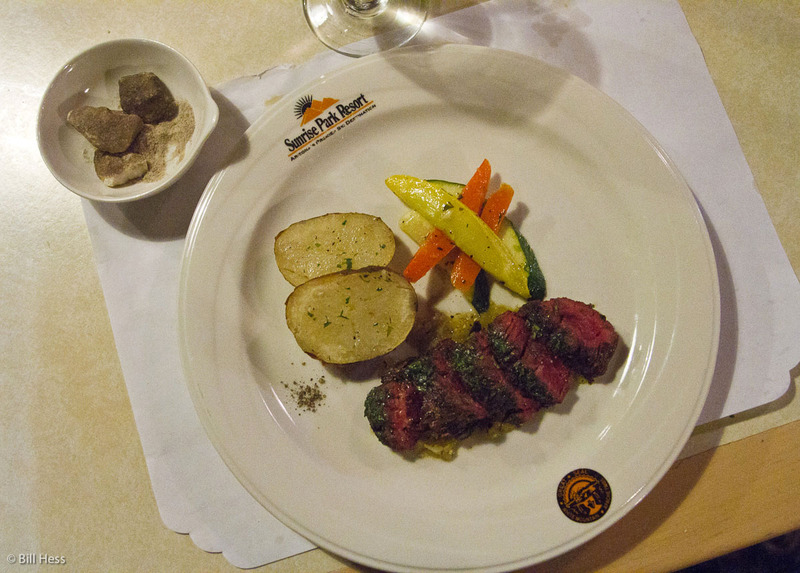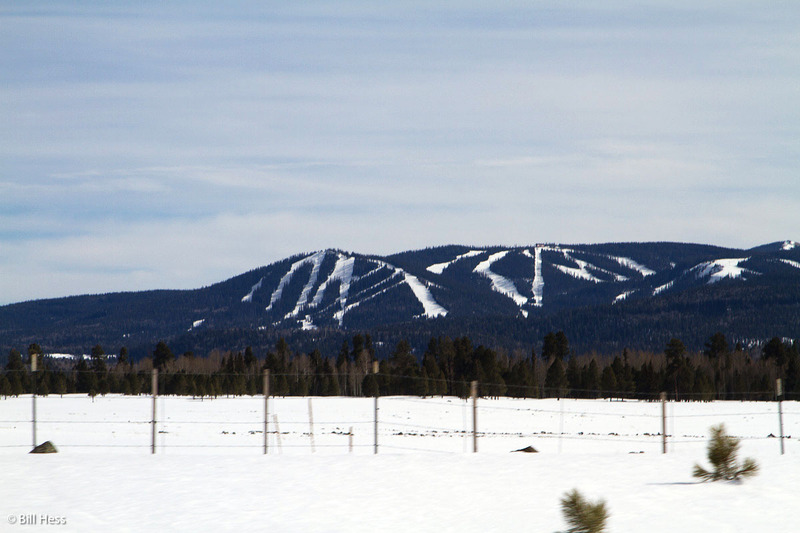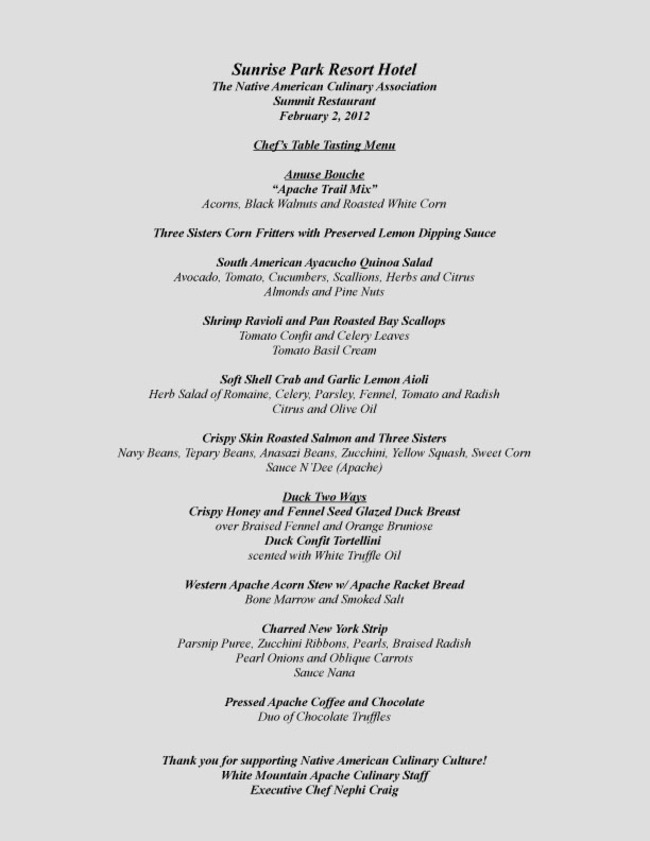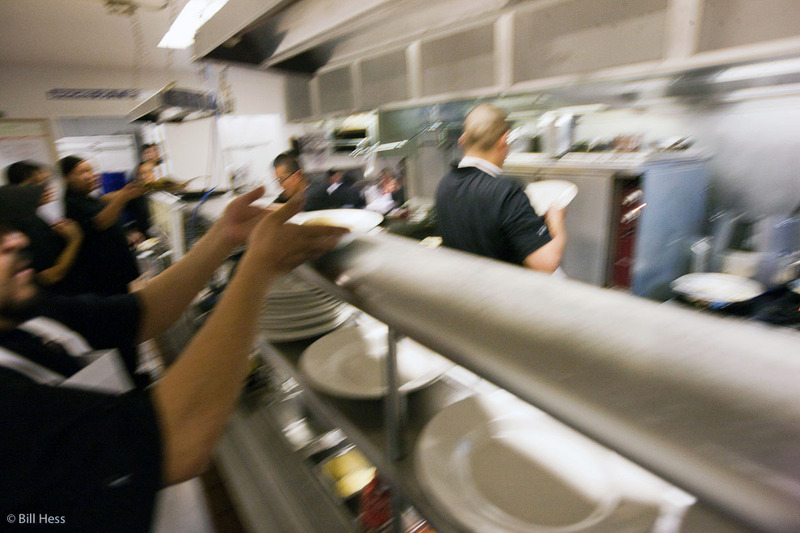Master Chef Nephi Craig, part 3: he first bakes bread in preschool, goes on to learn five star French cooking, then returns to his Apache/Navajo roots and serves a chef's table
 Thursday, April 5, 2012 at 12:25AM
Thursday, April 5, 2012 at 12:25AM When I look at this picture of Chef Nephi Craig at work, I immediately see three things: First, the intensity and drive that has made him a master chef at the young age of 32. Second, although he is more slender in both body and face, I see his dad, the late Vincent Craig - as good a friend as I ever had.
Vincent was a versatile and multi-talented artist who became famous in Indian country for his original music, his art, his cartoons, his poetry...
Third, and related to both the first and second, I see the passion of a dedicated artist, coupled with an analytical mind akin to a scientist.
"Every since I was a little kid, I was always cooking," Nephi told me. During the time that he grew up, his family moved back and forth between the White Mountain Apache reservation of his mother, the Navajo Nation of his father, and, very early in his life, Phoenix - where his dad went to school.
"One of my first memories of living in Phoenix happened at preschool. My teacher let me make banana bread or blueberry or some kind of muffins. She approached cooking like science and art and I got to actually bake. It was neat, it was cool to be able to cook, because cooking had always been something for adults. I was intrigued by the hands on experience, by mixing up the ingredients, by the hands on experience."
Back in their Whiteriver home, the Craigs lived a ways uphill from his grandfather's house. Nephi would often go down to visit and climb the trees that rose over his grandfather's garden. He was fascinated by the garden, by how the right amount of sunshine, coupled with water and love caused the seeds planted in that garden to grow into food that wound up on his plate.
His mother, Mariddie, would let him make cookies and brownies. "I realized I liked to cook. I wanted to do it more and more."
There, at his own home and those of friends, at camps and ceremonies, at the coming-of-age Sunrise dances held regularly for girls making the change into womanhood, he also got to eat Apache food and to see it made. He saw the cooking of the various kinds of bread - from that cooked over coals on hand-made wire devices that look like tennis rackets, to frybread and tortillas. He saw the many ways Apache cook corn, from baking it buried in the earth atop rocks heated in the coals to mashed patties cooked in frying pans.
He saw how acorns were gathered, and piñon nuts and witnessed the slaughter and butchering of cattle, then the steaks grilled over hot coals, or mashed and shredded into strands to add meat and broth to stews made from ground acorns.
"It was the same kind thing up in Navajo. I would see them butcher sheep, mutton and we would eat it right there. I did not really participate in the butchering and cooking. I would watch, eat - just experience it."
Now, after years of study and work under master chefs from whom he learned the long recogized fine art of French cooking, he has turned his attention back to the fine art of his own traditional cooking. As head chef over the all-Apache staff of 28 who work in the kitchen and restuarant at the tribally owned and operated resort hotel at the Sunrise ski resort, he has introduced Apache and other tribal foods onto the regular menu. He has also created a Chef's Table experience. Participants come right into the kitchen and sit at a table where they can see the line cooks and wait staff at work.
They are served meals of up to 11 courses - all of them based on the traditional foods of the Apache and other Native peoples indigenous to the western hemisphere. The experience can last up to three hours. It begins with a brief discussion of the philosophy behind Native cuisine and of its importance to the people, as he does above with Veronica Titla and her son Matthew of San Carlos Apache Reservation and Melinda Ivans of the White Mountain community of Seven Mile. Also at the table, but out of the frame is Steven Titla, another son of Veronica's.
Each course is then delivered with a summation of where it originated, and the benefits it has brought to those who eat it.
Nephi continued to cook through his high school years - regular dishes that any hungry teen might cook - like spaghetti - but perhaps with a little more dedication and attention to process. He enjoyed the cooking, he enjoyed the eating. He also loved science and math.
After high school, he knew he wanted to get into something artistic and creative. He greatly admired the art of his father and the photography and film making of his older brother, Dustinn. He briefly thought about following a similar course. He wasn't quite sure, so he decided to take a year off, but soon ran into trouble and difficulty.
"I had to make a decision really quick," he says. He loved to watch the Discovery Channel's Great Chefs of the World and believed he could learn to do everything he saw the featured chefs do. In October of of 1998, Nephi enrolled in the culinary program at Scottsdale Community College, just outside of Phoenix. He had no scholarship and so to support himself, took on a full-time job: cooking at The Country Club at DC Ranch in Scottsdale, under the tutelage of Executive Chef Chris Olson.
In the photo above, Nephi prepares the dough for three sisters fritters.
Nephi found himself working 40 intense hours a week on a high-pressure, cook line, even as he attended school full time - but he loved it.
"I liked being creative; I liked the hands on, I liked the science of it. As I got into school and started to cook professionally, the memories came rushing back."
Before he could finish his class studies, Nephi broke his ankle in a skateboard accident. Suddenly, it became too difficult to attend school and work full time. He needed money, he needed to pay his rent and he felt that he could learn what he needed to know at DC Ranch. "The most obvious decision was to keep my job working in the field I wanted to make my career, where I could get paid and receive tips." Nephi dropped out of college and continued to work.
He stayed at DC Ranch for just under five years. "I learned a lot from Chris. He kept me moving from station to station: saute, baking, catering... all the areas that I needed to learn. I worked hard. I didn't complain. My chef recognized my hard work and enthusiasm. He took an interest in me and coached me along a lot."
In the photo above, Nephi observes as waitress Daisy Tortice prepares to take salad to customers in the main dining hall.
Mary Elaine's at the Phoenician has been described as the most "uber fancy French restaurant in Scottsdale," perhaps in all Arizona - a five star, five diamond place. The most famous and respected French chefs from cities like New York and even Paris regularly came in to add their touch to the menu. Many young, aspiring chefs wanted to work there - including Nephi Craig.
Yet, only those who had already proven their talent and desire had a chance. Nephi applied, but anticipated a long wait. "I thought I might get accepted some time when I was in my thirties." He got in at the age of 22.
It was a big kitchen, with 17 lines cooks and extremely high standards. "It was tough, hard work - high pressure." Nephi witnessed co-workers break down on the job, quit, walk off the line and right out the door.
"It was good for me. I realized, more than I ever had at any other place, that I focus under pressure. Pressure brings out the drive in me. It was a lot of fun, and it also came with a lot of anger and frustration. In the end, it all paid off."
Even as he learned the art and discipline of French cooking, Nephi often thought about the Native food he had been raised with. He imagined how it might be incorporated into fine restaurant dining. During his time at Mary Elaine's he made a visit to the nearby Wild Horse Pass resort and casino on the Gila River Indian Community, which includes the Native-owned restaurant, Kai. The chef was preparing "Southwestern American Cuisine... with Native American influences. Nephi found the staff to be highly skilled and organized.
As he visited, he saw the chefs grow excited when they inspected a box of polenta shipped in from the midwest. They told him it was hand stone-ground polenta, high quality stuff, coarse and explained how they used it in various dishes. They spoke of it as a fine food from another culture.
When Nephi looked at the polenta, he thought, "Wow! This is just like my grandma's corn meal up in Navajo!" Yet, even though it was an tribally owned restaurant in Indian country, nothing they were doing with the polenta qualified as indigenous culture and cuisine.
"I realized we could produce some foods here that were even better. It became more apparent to me that I wanted to go into Native cuisine. It gave me that final push out the door."
Nephi realized that the philosophies behind the French cooking he had learned in the fancy restaurants and Native cooking were very different. The original great Fench chefs had been the chefs of kings. Their cooking separated classes and created a certain snobbery that remains in the culture. Nephi believes it was not that way among the people in the French villages, but the culture that now dominates in the fine French restaurants developed in the palaces.
In the Native culture that Nephi grew up in, the cooking and food was shared by everybody. It was respected, considered sacred. "If we wasted food, we got scolded."
He did experiment with combining French techniques and Apache food, but found the two incompatible. "It didn't make sense. The flavors changed. They were not recognizable. Classic Apache food, classic Navajo food, is the way it is for a reason." His goal then became to produce Apache food that tasted like... Apache food... the way a skilled grandma would make it. The same for Navajo cuisine.
He spent two weeks in Japan to prepare Apache acorn stew for a Native American cuisine tasting dinner. He wondered how it would go. Most Apaches love acorn stew, but many non-Apaches take one bite and then take no more. Yet, the feedback he got was good.
Nephi subsequently participated in cooking events in other countries, including Germany, Brazil and London. He would prepare meals of up to eight courses. most of them modern, but at least one would always include traditional Apache food. The response was always good. Diners were intrigued. Most had never even considered Native foods as restaurant cuisine.
Nephi was convinced that he could do something special with Native food in a professional way - "something physical, that would reach into our past. Our culinary traditions are very powerful. I felt the food had to honor our culinary traditions."
So he rerturned to Apache country and applied at Sunrise Park Resort, where he went to work as a line cook during the ski season of 2009-2010. "The first time I walked in, I saw that the whole staff was Apache. I was blown away. This was amazing."
Yet, there was no Apache food on the menu. The restaurant was not well organized. It served what struck him as "pretentious food" chosen because someone thought it would appeal to skiers. At the end of the season, the head chef left of his own choice. Nephi was offered the job and he took it. When the Sunrise Park Resort opened for the ski season of 2010-2011, the menu included Apache food, cooked right.
Nephi knew that he had to please a wide variety of people, not only from the US but around the world and that not everyone could appreciate Apache food, so he kept more main-stream on the menu as well.
Staff members from left to right: Vincent Way holding white plate, Patricia Reidhead(waitress), Daisy Tortice(waitress) holding skillet, Chelsey Clawson(waitress) looking on. Nephi and Marques Hinton.
Nephi had sometimes seen chefs who yelled at their workers; he had seen tempers flare across the cook line as the pressure and tension grew. He knew this approach would not work with an all-Apache staff.
"We worked hard together to build everyone's self-confidence. They had to trust me to lead them. We are a small group of people, me and 14 cooks, 14 wait staff."
Nephi's Chef's Table guests observe as he pulls freshly cooked frybread from a vat of hot oil - not for them - their patties of bread will be much smaller - they are eating ten courses after all. This frybread is for someone out in the main dining room, someone who has ordered Apache tacos.
One of the ten courses is soft-shell crab from the Pacific Northwest (salmon is another). After deep frying the crab, Nephi adds garnish to make the plate beautiful.
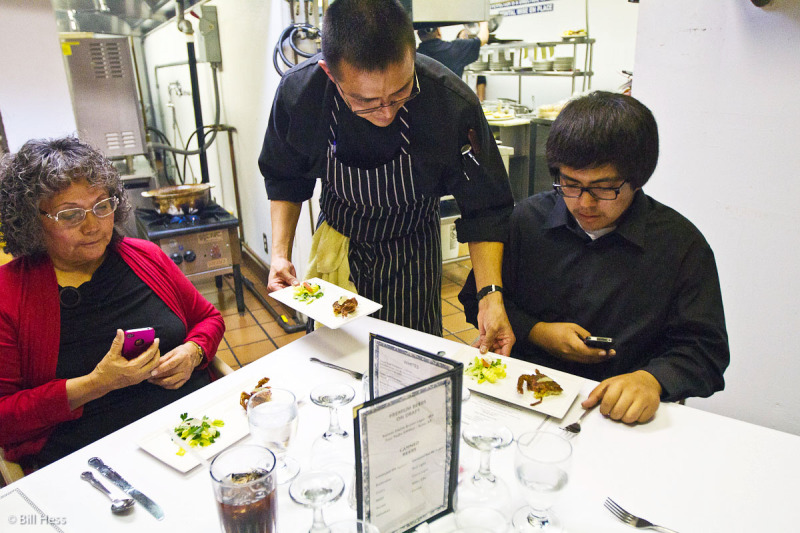
On this night, each one of his guests took of a photo of every course served to them - in part because 15 year-old Matthew is already thinking about becoming a chef himself, and wants to take someting home that he can study later.
Melinda Ivans begins to eat her crab.
There is a healthy combination of food called "three sisters" that is considered sacred in many Native cultures: beans, corn, and squash - here zucchini, yellow squash, tepary beans, Anasazi beans and sweet corn, with tomatoes, herbs and citrus.
After his father died, Nephi suffered a bout with alcohol abuse, but has been clean and sober now since becoming head chef. "I have a sense of clarity. I know what I am doing in terms of culture. Having a lucid and clear mind helps me to see the importance of being humble and respectful of tradition. It keeps my heart open to the subtle forces of culinary tradition. A clear mind helps me to see and gauge my staff as they work in a stressful environment."
As many diners enjoy their wine and beer, Nephi says some chefs who have an alcohol problem sometimes seek to excuse their behavior by describing themselves as specialists in food and wine. "I don't deny my guests the drink of their choice, but staying sober keeps me very alert. This is a job that requires a lot of attention to detail. Some people think cooking food is just walking around, wearing a chef's hat and smiling all the time."
"It's not. It's very demanding, taxing. It requires a good sense of judgment."
None of his staff have been to culinary school, so Nephi worked with them to create "a workshop environment that supports learning and places a high value on mentorship. We focus on training and it is important to our staff to understand the language, the culture of professional cooking.
"We have taken the classical French Brigade model and amended it to mirror the concept of the Apache Band where each individual has a "power" (role or talent) and each 'power' is equally respected, from dishwasher to Chef, each role is crucial to the entire human-driven operation that is our restaurant. Much of what we rely on to operate as a crew are qualities of Apache leadership that are already in place for generations. We simply apply them to our kitchen and they work brilliantly because they are universal human qualities as well."
It is not only high pressure, fast moving, but potentially dangerous work. Amidst flames, metal heated to flesh-searing temperatures, knives abound. Staff hurriedly weave their way through narrow, crowded spaces. "Behind!" they alert each other as they pass.
Not everyone has made it. The intensity and high pressure has been too much for some, but Nephi describes those who stayed, who I found working with him that night, as dedicated and skilled. And never, in the very intense, fast-moving three hours that I spent with them, did I see anyone grow angry, yell, scold or bawl out another.
Voices sometimes rose for emphasis, but never to the point of anger. "Cooking requires heart, character," Nephi says. "Cooking is character driven work." Marques Hinton cooks at the saute station.
Towards the end of the evening, Nephi prepares the dough he will use to make the grilled Apache bread that will accompany the acorn stew and bone marrow course.
This is the beef that will go into the stew. When Margie and her family make acorn stew, they shred the beef. Nephi, who is continually educating himself on how his people cook, chooses to dice the beef.
Nephi pours the broth through a strainer.
He reaches for the bowls that contain the beef.
"Our history is a tragedy to look at from the outside. The irony is that something very beautiful, very cool, is happening here. I feel blessed and excited to be a part of it."
In terms of food, one cannot get more Apache than this - bone marrow, grilled bread and a bowl with diced beef that will soon be floating in acorn stew.
Veronica cannot hide her delight. She has eaten bone marrow many times, but has never before had it served to her in a restaurant. "For us Apaches, this is our favorite part!" she laughs as she points to the bone marrow.
"Everything is delicious and it’s wonderful to be served by a by one of our own - a whole crew of Apaches. I’m glad they’re taking care of us, everything has been just delicious. It’s a small portion, not as much as what we’re used to, but all the other food that he presented to us makes up for it - and this does taste just the way we would make it."
"It’s so amazing and unique," Melinda adds. "It's different – everything is just beautiful. It’s good. I don’t do it just the way he does, but still it is Apache food and it is good."
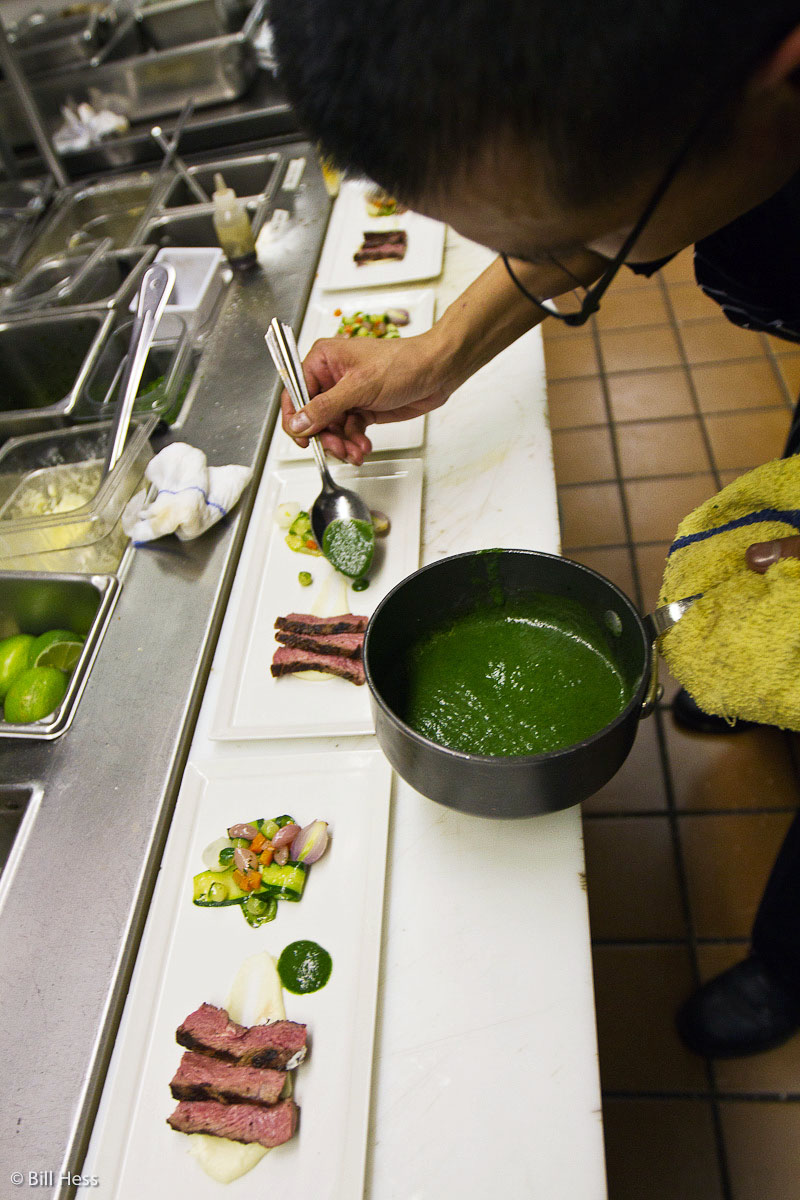
New York Strip, parsnip puree, and Sauce Nana.
Much of the food comes direct from the White Mountain Apache community, from the traditonal corn fields of tribal members to beef from Apache cattle owners.
Nephi recalls the words of one lady who dined here: "Wow! I always knew our foods were special. Wow, now they are made even more special."
"These dishes spark a lot of memories. Food is very powerful."
Even the salt Nephi sprinkles upon the steak is traditional Apache cuisine, as it comes from the salt banks of the Salt River.
"I am excited to see where Native food is going to go and how it will continue to evolve. I feel blessed be a part of it. I feel fortunate to be sober, to be helping it happen. It reminds me of my dad, of his song on one album about a weaver. With our food, I weave a very intricate culture. It is beautiful to me. I hope to be able to continue to share it and to convey the same message my dad did."
In case anyone has forgotten, coffee is also a Native drink, first cultivated in Meso America. It is also part of the dessert Nephi serves to his chef's table guests, prepared in a French press and from my own experience, I can tell you it is exquisite.
The other part of the desert - Chocolate Truffles with Black Walnuts from the trees Downbelow in Whiteriver - prepared fresh in this kitchen, is also a traditional Native food.
Nephi and waiter Ivoury Thomas carry the dessert to their chef's table guests.
Nephi serves Matthew, who also hopes to become a chef. "I want to learn how to cook. It will be a new experience," he explains.
Three hours have passed. The Chef's table dinner is over. The guests linger to visit with Nephi. "It was very enjoyable, very worth it,' Veronica says. "We ate Native food all the way from Alaska to the tip of South America. It’s wonderful. I’m proud of him. I’m really proud of him. It is busy in here.
"We don’t want to leave! We want to go another round!"
Nephi takes a short break before continuing to cook for other customers out in the main dining area. It is hot in the kitchen and he has been working hard and non-stop. He takes a drink of sparkling water to quench his thirst.


